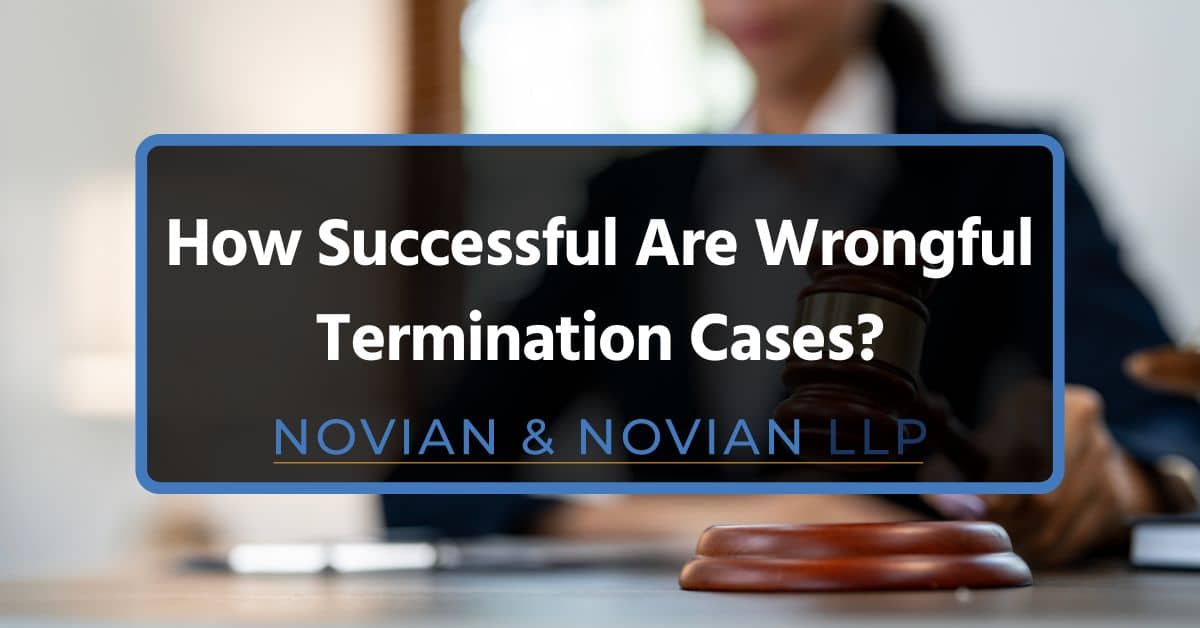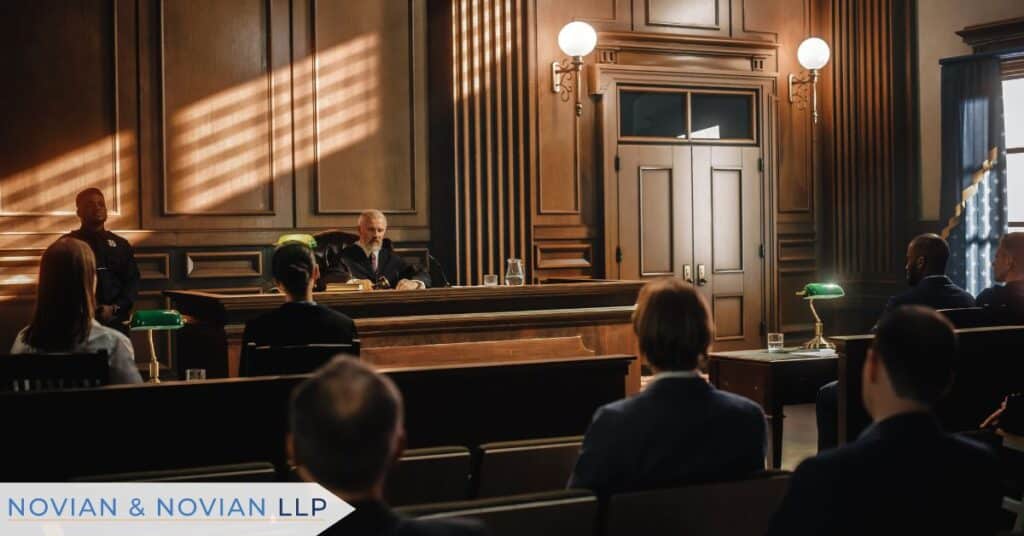
| July 22, 2024 | Employment Law
Wrongful termination occurs when an employee is fired for illegal reasons. While the success rate of wrongful termination cases varies, many employers can achieve favorable outcomes, particularly when they have strong evidence and experienced legal support.
At Novian & Novian, we specialize in defending employers in wrongful termination cases. Our team of experienced wrongful termination defense lawyers in California is dedicated to helping you achieve the best possible outcome. If you are involved in a wrongful termination case, contact us for expert guidance and support.
This blog will cover the concept of wrongful termination and how successful cases are. It would also give tips on how to increase the chances of the case winning.
What is a Wrongful Termination Lawsuit
A wrongful termination lawsuit is filed by an employee who believes they have been unlawfully dismissed from their job. This can occur when an employee is fired for reasons that violate state or federal laws, such as discrimination, retaliation, or breach of an employment contract.
A wrongful termination claim usually has a negative impact on businesses as it can lead to financial losses, reputational damage, and potential legal costs. Businesses may also experience lower employee morale and productivity if wrongful termination claims are perceived as a sign of poor management practices.
If you find yourself facing a wrongful termination case, you need wrongful termination attorneys. A wrongful termination defense lawyer specializes in defending employers against claims of wrongful termination. Their purpose is to protect businesses from unfounded claims and to ensure that any legitimate claims are resolved fairly. An experienced wrongful termination lawyer can help businesses by providing legal defense, negotiating settlements, and advising on employment practices.
In addition, the cost to defend an employment lawsuit can vary and can go up to $125,000. It typically includes legal fees, settlement costs, and potential damages awarded if the case goes to trial.
Furthermore, the chances of an employee winning a wrongful termination lawsuit depend on the strength of their evidence and the expertise of their legal representation. While many cases are settled out of court, those that proceed to trial can result in favorable outcomes for the employee if they have a compelling case.
What Qualifies as Wrongful Termination?
Wrongful termination can happen due to several reasons, including but not limited to:
- Wage Dispute: Disagreements over unpaid wages or salary discrepancies.
- Constructive Discharge: When an employee is forced to resign due to intolerable working conditions.
- Sexual Harassment: Termination resulting from reporting sexual harassment.
- Racial Discrimination: Being fired due to race or ethnicity.
- LGBT Discrimination: Termination based on sexual orientation or gender identity.
- Gender Discrimination: Being dismissed due to gender or pregnancy.
- Employer Retaliation: Retaliation against an employee for whistleblowing or reporting illegal activities.
- Age Discrimination: Termination based on a person’s age.
- Disability Discrimination: Termination based on disability.
- Violation of Public Policy
- Breach of Employment Contract: Going against the terms of the employment contract.
The Success Rate of Wrongful Termination Cases
The success rate of wrongful termination cases can vary widely based on several factors, including the strength of the evidence, the quality of legal representation, and the specifics of the case. Many wrongful termination cases result in favorable outcomes for the employee, either through settlements or court verdicts.
Successful cases can result in compensation for lost wages, damages for emotional distress, and even punitive damages in some instances. Settlements are particularly common, as they offer a quicker and less costly resolution for both parties. When cases do proceed to trial, employees often win if they have compelling evidence and strong legal representation.
Often, employment law attorneys for both sides recommend settlements to avoid the unpredictability of jury decisions. Most wrongful termination cases do not go to court for several reasons, including cost and time, risk of uncertainty, privacy concerns, legal strategy, etc.
Is the Wrongful Termination Charge Valid?
To establish a valid wrongful termination charge, there must be proof of certain elements. These elements can include evidence of an employment contract or implied contract, documentation of wrongful termination grounds and witness testimonies.
For example, an employment contract can be written, oral, or implied. An implied contract might be established through company policies or practices that suggest continued employment unless there is a valid cause for termination.
Furthermore, there should be evidence of wrongful termination grounds. This can include evidence of discriminatory remarks, retaliation actions, or other unlawful reasons for termination. Examples might be emails, performance reviews, or other documents that indicate illegal behavior by the employer.
In addition, the plaintiff (employee) can present witness testimonies and supporting documents. Testimonies could be from co-workers or other witnesses who can corroborate the employee’s claims are crucial. Supporting documents could include emails, text messages, and memos that strengthen the case.
Moreover, experienced wrongful termination attorneys play a huge role in proving these elements. Their expertise in employment law and their ability to craft a compelling legal strategy can significantly influence the outcome of the case.
Factors Influencing the Success of Wrongful Termination Cases
Several factors can affect the success of a wrongful termination case. One such factor is the force of evidence presented. A wrongful termination claim must have strong, clear, and convincing evidence. The more substantial the evidence, the higher the chances of a successful outcome.
Another factor is having an experienced employment law attorney. An effective legal team can help you navigate the complexities of employment law, gather the necessary evidence, and present a compelling case. At Novian and Novian, our experienced employment law attorneys are dedicated to providing aggressive legal representation and helping clients achieve successful outcomes in wrongful termination cases. If you believe you have been wrongfully terminated, don’t hesitate to seek our expert legal help.
Furthermore, the credibility of those providing testimony, including the plaintiff, can heavily influence the case. Honest, reliable witnesses can sway the outcome in favor of the employee. The employee’s work history and any previous legal issues can also impact the case. A positive work history can strengthen the employee’s position.
In addition, the success of the case may depend on jurisdiction and local labor laws. In California, for example, the California Fair Employment and Housing Act (FEHA) prohibits discrimination based on race, color, national origin, ancestry, religion, sex, disability, marital status, sexual orientation, gender identity, age, and more. This law applies to employers with five or more employees. The California Family Rights Act (CFRA) also provides eligible employees with up to 12 weeks of unpaid, job-protected leave per year for family and medical reasons. This law applies to employers with 50 or more employees. As an employer, you must be familiar with these laws. Going against them can leave you facing a wrongful termination lawsuit.
The Legal Process Guide
The process of a wrongful terminal case begins when an employee feels they have been wrongfully terminated and decides to appeal the termination. This step involves formally notifying the employer and sometimes a relevant employment authority or commission like the EEOC about the grievance. As an employer, this is the stage where you receive an appeal.
The next stage involves consulting with a wrongful termination defense lawyer. The lawyer will evaluate the case, explain the legal options, and guide you through the process.
As an employee, your next step would be to file a complaint with the relevant state or federal agency, such as the Equal Employment Opportunity Commission (EEOC). This complaint outlines the reasons for the wrongful termination claim and provides initial evidence.
Once the complaint is filed, the employer will receive a notification and has to respond to the complaint. The employer’s response typically includes their version of events and any supporting documentation to refute the claim.
The next step for both parties is the evidence collection stage, also known as the discovery stage. During the discovery phase, both parties gather evidence to support their claims. This may include collecting documents, emails, performance reviews, witness statements, and other relevant materials. Both parties may also take depositions from key witnesses.
Next, all parties have to prepare for trial. Preparation for trial involves finalizing the evidence, developing legal strategies, and preparing witnesses for testimony. Both parties’ lawyers will work on presenting a compelling case to the judge or jury.
During the trial, both parties present their evidence and arguments. Witnesses are called to testify, and both sides have the opportunity to cross-examine. The judge or jury then evaluates the evidence and arguments presented.
After the trial concludes, the judge or jury delivers a verdict. If the employee wins the case, they may be awarded compensation for lost wages, emotional distress, and possibly punitive damages. If the employer wins, the case is dismissed.
In the post-trial period, either party may appeal the decision if they believe there were legal errors that affected the outcome. Additionally, the enforcement of the judgment, such as the payment of damages, is handled during this time.
It can take several months to even a few years to resolve wrongful termination lawsuits. The timeline depends on the complexity of the case and whether it is settled out of court or goes to trial.
Possible Outcomes
One of the most common outcomes of wrongful termination cases is financial compensation for the wrongfully terminated employee. This compensation can include back pay of wages that the employee would have earned from the time of termination to the resolution of the case or front pay of future wages lost due to the termination. It could also include punitive damages and compensation for emotional distress.
In some cases, the court may order the employer to rehire the wrongfully terminated employee. This is more common in cases where the employee’s role was unique, and the termination was clearly based on discriminatory or retaliatory motives.
Furthermore, employers found guilty of wrongful termination can suffer a great deal to their reputation. This can impact their ability to attract top talent and may affect relationships with customers and partners. They can also suffer loss of business licenses or contracts, especially if the wrongful termination was part of a pattern of illegal behavior.
As an employer, you must avoid being involved in a wrongful termination case, as it usually has a long-term impact on the business. Typically, such cases bring about increased scrutiny from regulators and industry bodies. It also dampens employee morale which could lead to higher turnover rates.
How Employers Can Avoid a Wrongful Termination Lawsuit
Employers can avoid a wrongful termination case by implementing clear and transparent workplace guidelines. This helps ensure that all employees understand the company’s expectations and policies. It also reduces the likelihood of misunderstandings that can lead to wrongful termination claims.
It is also important to have detailed documentation practices. This includes maintaining thorough and accurate documentation of employee performance, disciplinary actions, and communications. All these can provide a strong defense against wrongful termination claims.
As an employer, you must give fair and impartial treatment to all employees regardless of their background or position. This helps prevent claims of discrimination or bias. You should also establish clear and open communication channels that allow employees to voice their concerns and grievances without fear of retaliation. This can help resolve issues before they escalate to wrongful termination claims.
Furthermore, implementing a step-by-step disciplinary approach ensures that employees are given fair warning and an opportunity to improve before termination. This process typically includes verbal warnings, written warnings, suspension, and finally, termination. It is also helpful to provide regular training and education on employment laws and best practices for managers and HR personnel. This can help prevent unintentional wrongful terminations.
Wrongful Termination in California
In California, wrongful termination claims are handled within a well-defined judicial system that includes state and federal courts, depending on the nature of the claim. California has robust legal directives aimed at protecting employees from unlawful termination, and employers must adhere to these laws to avoid potential lawsuits.
The state’s employment laws provide various protections under acts such as the California Fair Employment and Housing Act (FEHA) and other labor codes. Employees who believe they have been wrongfully terminated must file a claim within the statute of limitations, which is typically two years from the date of termination.
In California, the burden of proof in a wrongful termination case lies with the employee. To establish a claim, the employee must provide evidence that the termination was based on an illegal reason, that they were qualified for the job and performing their duties satisfactorily, and that the termination resulted in damages such as lost wages or emotional distress.
Defending an employment lawsuit, including wrongful termination claims, can be costly for employers. Legal fees, court costs, and potential settlement expenses can accumulate quickly. On average, the cost to defend an employment lawsuit in California can range from $75,000 to $250,000 or more, depending on the complexity and duration of the case.
Furthermore, the average payout for wrongful termination cases in California can vary widely based on the specifics of each case, including the severity of the violation, the employee’s salary, and the duration of unemployment. Settlements and court awards can range from thousands to millions of dollars. Higher payouts are possible in cases involving severe discrimination, retaliation, or other egregious behaviors by the employer.
Need a Defense Lawyer to Fight with a Wrongful Termination Lawsuit?
The success of a wrongful termination case largely depends on the strength of the evidence and the quality of legal representation. While many cases result in favorable settlements for the employee, achieving a successful outcome requires thorough documentation, credible witnesses, and a compelling legal strategy. Employers must ensure compliance with employment laws to avoid potential lawsuits and protect their businesses, as California’s legal framework protects employees from unlawful termination. However, the responsibility to provide evidence of wrongful termination lies on the employee.
If you believe you have been wrongfully terminated, seeking legal advice is best. An experienced wrongful termination lawyer can help you navigate the complexities of employment law, gather necessary evidence, and advocate on your behalf to achieve a fair resolution.
Novian & Novian is the best Los Angeles Employer Defense Practice. Our team of skilled employer defense attorneys is dedicated to defending the rights of employers. If you need a strong defense against a wrongful termination lawsuit, contact us today!
Contact Us
Have questions about this post? Novian & Novian is a full service law firm in Los Angeles with clients that span the country. Contact us today for a free consultation.
Contact Us
Have questions about this post? Novian & Novian is a full service law firm in Los Angeles with clients that span the country. Contact us today for a free consultation.




